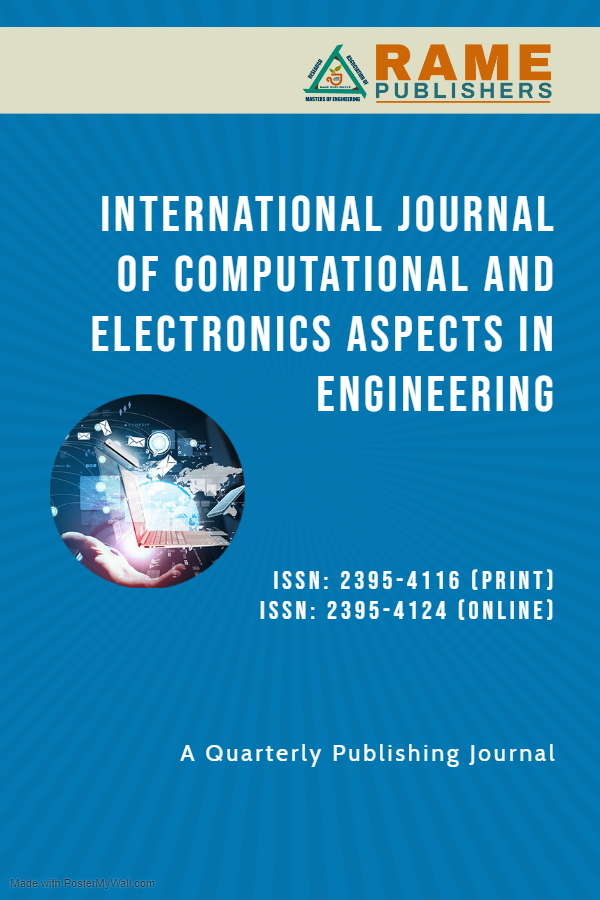Design Automation for IC Engine Cooling System using Application Programming Interface
Siddharth Yadav, Swanand Pachpore
International Journal of Computational and Electronic Aspects in Engineering
Volume 3: Issue 2, June 2022, pp 8-12
Author's Information
Siddharth Yadav2
Corresponding Author
2Department of Mechanical Engineering, Dr. Vishwanath Karad MIT- World Peace University, Pune, India
siddharth.yadav1000@gmail.com
Swanand Pachpore1
1Department of Mechanical Engineering, Dr. Vishwanath Karad MIT- World Peace University, Pune, India
Abstract:-
These In recent years, the intense competition in development of new products followed by their rapid prototyping has given rise to an intense competition in the market. In order to automate the design, development of Application Programming Interface (API) is most commonly followed method. The presented work showcases an attempt to develop an API for calculation of area of Heat Exchanger required for an IC Engine. The sAPI has been developed using two commonly used coding languages – HTML (Hypertext Markup Language) and Java script. The HTML along with the integration of CSS is used to develop the user interface and the mathematical formulae have been formatted into the Java script. The API is focused towards understanding the combined effect of various parameters in a heat transfer system.Index Terms:-
Design Automation, API, IC Engine, Heat Transfer, HTML, Java scriptREFERENCES
- Swanand Sudhir Pachpore, Manoj Botre, Ratnakar R Ghorpade and Pradeep V Jadhav. "Knowledge Based Engineering and Its Application in Engineering: A Review." International Journal for Scientific Research and Development 8.1 (2020): 453-463.
Online - Swanand Sudhir Pachpore, Rishil Shinde, Swapnil Rathod, Tushar Ekar and Shubham Bhongade. " Development of API for Estimating Torsional Strength of Shaft through Knowledge-Based Engineering Approach." International Research Journal of Engineering and Technology Vol. 7, Issue 7 , July – 2020, p-ISSN: 2395–0072.
Online - Mayura Ghatti, Kajol Ghatole, and S. S. Pachpore , "Optimization in spring design using knowledge based engineering approach", AIP Conference Proceedings 2358, 040002 (2021) .
Crossref - Powell, T. Thomas A. Powell, "HTML: The Complete Reference, Fifth Edition", Osborne/McGraw-Hill.
- Gilmore, M.L. (1989), “Knowledge Based Systems in Construction and Civil Engineering”, Project Management, Vol.7, Issue 3, PP.147-153.
Crossref - Vosniakos, G.C. (1992), “Knowledge Based Interpretation of CAD Drawing Annotation for Mechanical Engineering Components”, Computer Aided Design, Vol. 24, Issue 10, PP. 547-555.
Crossref - Changchien, S. W., et.al (1996), “A Knowledge-Based Design Critique System for Manufacture and Assembly of Rotational Machined Parts in Concurrent Engineering”, Computers in Industry 32, PP.117-140
Crossref - Albert K. W.Wu. (1997), “A knowledge-based application in engineering”, Advances in Engineering Software 28, PP.469-486.
Crossref - Chapman, C.B., et.al (2001), “The Application of Knowledge Based Engineering Approach to the Rapid Design and Analysis of Automotive Structure”, Advances in Engineering Software 32, PP. 903-912.
Crossref - Sapuan, S.M. (2001), “A Knowledge Based System for Materials Selection in Mechanical Engineering Design”, Materials and Design 22, PP. 687-695.
Crossref - Kong, L., et.al (2003), “A Windows-Native 3D Plastic Injection Mold Design System”, Journal of Materials Processing Technology 139, PP.81-89.
Crossref - Lin, Bor-Tsuen., et.al (2008), “Automated design system for drawing dies”, Expert Systems with Applications 34, PP.1586-1598.
Crossref - Rocca, G. (2012), “Knowledge based engineering, Between AI and CAD Review of a language-based technology to support engineering design”, Advanced Engineering Informatics 26, PP.159-179.
Crossref - Nayak H. Betal (2012), “Drawing Automation of Reactor Nozzle”, International Journal of Engineering Research and Applications, Vol.2, Issue 1, PP. 281-286.
Online - Lad, A.C., et.al (2014), “Design and Drawing Automation Using Solid Works ApplicationProgramming Interface”, International Journal of Emerging Engineering Research and Technology, Volume 2, Issue 7, PP 157-167.
Online - Belkadia, F., et.al (2015), “Knowledge based and PLM facilities for sustainability perspective in manufacturing: A global approach”, The 22nd CIRP conference on life.
Crossref - Olofsson,J., et.al. (2018), “A methodology for microstructure-based structural optimization of cast and injection moulded parts using knowledge-based design automation”, Advances in Engineering Software 109, PP. 44-52.
Crossref - Jon Duckett, ‘’Beginning HTML, XHTML, CSS, and JavaScript’’, Wiley Publishing, Inc.
- Wendy Willard, ‘’HTML a beginner’s guide’’, McGraw Hill.
- Michael Bowers, ‘’Pro CSS and HTML Design Patterns’’, A press publications.
- Jon Duckett, ‘’HTML&CSS design and build websites’’, John Wiley & Sons inc.
- Herbert Schildt, ‘’Java the complete reference’’, Osborne/McGraw-Hill.
- Jennifer Niederst Robbins, ‘’Learning Web Design’’, O’REILLY Publications.
- P.K. Nag, Heat and Mass Transfer, McGraw Hill Education India Private Limited.
- W. M. Kays & A. L. London, Compact Heat Exchangers – Kreiger Publishing Company.
To view full paper, Download here
To View Full Paper
For authors
Author's guidelines Publication Ethics Publication Policies Artical Processing Charges Call for paper Frequently Asked Questions(FAQS) View All Volumes and IssuesPublishing with




